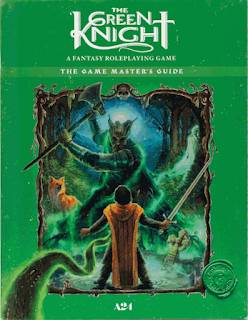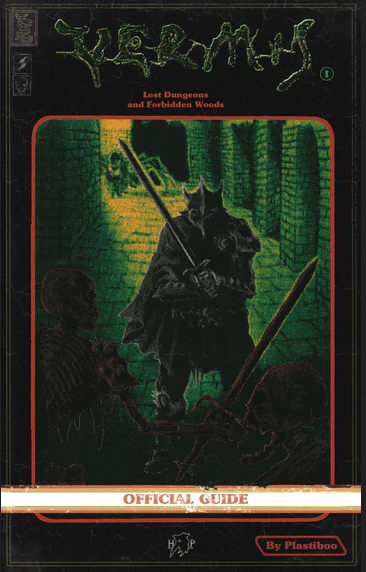Running Vermis; or "oracular meta-fiction as roleplaying setting"
Vermis & Vermis 2 are sensational, aesthetically rich and inspiring game books. They are, if you're unfamiliar, "game guides for games that don't exist"- written as picture and lore-heavy strategy guides for old pixelated dungeon-crawlers like Stonekeep and Eye of the Beholder. They take a lot of inspiration visually and tonally from Dark Souls and the bleak, gothic action rpg genre popular since the 2010s. If you're curious, I have reviews of both Vermis 1: Lost Dungeons and Forbidden Woods and Vermis 2: Mist & Mirrors which should give a pretty clear picture. How, though, are you supposed to actually use these as gamebooks? There are a few challenges:
- They are systemless, using only vague stats with no explanation
- They are vague, hinting at the world and its denizens rather than instructing you
- They are disorganized, functioning as a puzzle for the reader to piece together while flipping through, with no page numbers or index or uniform section structure
With that, here is a short overview of the primary adventure sites in the book, sorted into Dungeon and Wilderness categories. I have read, re-read, re-re-read, and taken notes to decipher the meta-fiction into functional RPG information (which was super fun to do!), so here is how you could approach using the locations. The number shown is the order they appear in the book and the linear progression of the "game". I've left a few out (Pestilent Mines, A Dream, A House Without Windows, A Room Without Shadows) because they are not clear enough where they are or what is going on in them to flesh out a full "area". They're more like flavor or mini-encounters. I offer suggestions for both how to pluck locations out as one-shots or maintain the implied linearity of the guide book, and have another post describing sessions in which I ran Pauper's Catacombs, Silver Swamp and Flutewood Forest and comparing different systems for each.
Dungeons
Graveyard (1): Presented very out of sequence, this one is hard to parse. Its map comes at the end, and it's kind of hard to figure out whether there are sub-areas like the crypt, high burial ground, etc, or if it is all meant to be one area, but it does have a strong "video game level" feel. It is the first area presented in the book, so in a "linear" presentation in the style of a video game, it would logically come first.
Pauper's Catacombs (2): A solid dungeon map, good pictures to show for reference. A mysterious magic statue that seems kind of like a Resident Evil puzzle, and some more statues that stalk you through the dungeon. Short and sweet, easy to use. It's what I would recommend as a first foray into Vermis, unless you want to run it linearly, but it is still the second area presented, so a combo of Graveyard & Catacombs could work well.
Green Sun Ruins (5): A clear isometric, multi-level map with labeled encounters. It's goblin-focused, which out of the context of Vermis could be lame, but the Vermis goblin lore is pretty good. The tone is kind of Zelda-ish, but with kind of a dusty, mysterious Shadow of the Colossus vibe. It has a substantial amount of information about the various encounters and a good closure in the form of the Goblin Princess's tomb chamber. It is by a significant margin the most cohesive and developed adventure area. It leads efficiently to The Highlands, and can even provide a nice hook to make the journey feel cohesive moving forward.
Shade Sanctum (7): Contains The Labyrinth, a large maze which is hinted to be a multi-level (possibly bottomless) megadungeon. It is depicted as kind of echo-ey and empty, with more strange statues, but it has a substantial amount of higher-difficulty, unique monsters shown in its section of the book. The first level is mapped and laid over a second, larger level which can't be clearly read. The rooms are not numbered on the map and the numbers which appear in the book are out of sequence. It could make a great template for a megadungeon of your own, if you're up for stocking one. If you want low prep, you could use encounter tables and some kind of random layout generator for anything below the first level. It ultimately leads to the Drowned Labyrinth location, implied to be the lowest level and that is where the narrative ends.
Wilderness
The Silver Swamp (3):This area would work as a point crawl. It has some great features and one of the easiest "random encounter" bestiaries in the book. A few are even solid NPC-style encounters, giving the opportunity to build a living world. It could do with a bit of prep, but it's got a lot of haunting and surreal aspects in it. The Aspect of Dream and Emerging Visage are my favorites. It is unclear how it is connected to The Pestilent Mines or A Dream. I chose to use the Mines as a single location in my point-crawl and the Dream as a part of the whole Swamp description. As it is a larger area, it could be harder to segue to the next area if you are taking the linear approach.
The Flutewood Forest (4): An open environment, with the text suggesting that it is open and mysterious, though haunted by a full 12 types of denizens. It gives slight Aokigahara Forest vibes, and has hints of dark druidism and the god Murgo. It also leads to the House Without Windows, one of the most iconic Vermis locations. I found it somewhat hard to flesh out a forest, so I stuck to "paths" that players could follow (I guess a point-crawl) with the option to stray between them at a higher risk. Like the Swamp, it will be difficult to naturally filter things toward the next planned location.
The Highlands (6): A linear progression including 2 rich encounters, in the form of a "False Witch" and a giant, imposing knight who defends a perilous bridge. Both encounters have scripted outcomes in the guidebook, as it's emulating a game, but they have awesome potential. This probably shouldn't be run on its own, but it leads into The Shade Sanctum.
What to do with all this stuff?
So it's all a little more laid-out for you now. Hopefully this has reduced the necessity to read this book 1-2 times through, though you still should! Spend time with these books and let it inspire you. Now you have an overview of the "levels" of the game, what type of adventure format they're suited to, how they connect together and which to use if you don't care about the linearity and want one-shots or locations for another type of game. There are still no stats- you'll have to figure out what to do with the character classes, the items, the monsters, any traps or mechanics, all of that is still left out and in need of Referee creativity. There's no clear, explicit story- from what I can tell it's largely about the Goblin Princess and the effect her influence and death had on the world, and the cycle of death, rebirth, and loss of identity the main character struggles with. Vermis II shares more, if you're interested. However, it remains a primarily tone- and aesthetic-based game product, and you will have to make more of it from that.
My goal here was to make the world more accessible for adventure, so that you and your group can create stories, history, success and tragedy on your own. Hopefully I've been of some service








So cool, I am become rat man
ReplyDelete